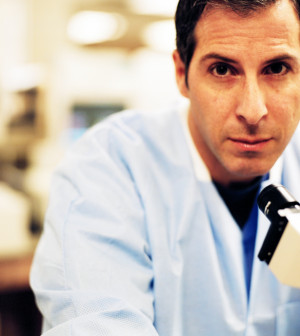- Understanding the Connection Between Anxiety and Depression
- How Daily Prunes Can Influence Cholesterol and Inflammation
- When to Take B12 for Better Absorption and Energy
- Epsom Salts: Health Benefits and Uses
- See What Saffron Can Do for Sleep and Heart Health
- 6 Common Mistakes to Avoid Before Your Physical
- Can Sweating Really Help You Beat a Cold?
- Strengthening Your Relationship: Practical Strategies
- Skip Storing This Everyday Product in the Fridge Door
- Green Tea + B3 Pairing May Boost Brain Health
Medicaid Patients Get Worse Cancer Care, Studies Contend


Medicaid patients appear to receive worse cancer care than people who can afford private insurance, a trio of new studies says.
Those covered by Medicaid, the federal health plan for low-income people, are less likely to have their cancer caught at an earlier, more treatable phase. Medicaid patients also are more likely to die from cancer than people with private insurance, researchers found.
Many factors likely contribute to this, including the fact that Medicaid patients often aren’t experienced in navigating the health care system, said Dr. Jyoti Patel, an oncologist at the Robert H. Lurie Comprehensive Cancer Center of Northwestern University in Chicago.
“Research has shown that we can screen more patients, but that they get dropped along the way to treatment. We don’t give them full access into curative therapy,” said Patel, who’s also a spokeswoman for the American Society of Clinical Oncology. “We need to do a better job to make sure that people who aren’t savvy or can’t advocate for themselves have that helping hand.”
The three studies each focused on a different type of cancer and how insurance affects screening or care for patients. They all were presented this week at the American Society of Clinical Oncology annual meeting in Chicago.
The first involved Hodgkin lymphoma, with researchers from the University of Tennessee, Memphis, reviewing data for 6,395 patients treated for the cancer between 2007 and 2010.
Doctors were more likely to catch the person’s lymphoma at an earlier stage if they had private insurance. About 59 percent of people with private insurance received a diagnosis before cancer had a chance to spread throughout their body, compared with 50 percent of Medicaid patients.
Medicaid patients were less likely to receive radiation treatment with just 35 percent undergoing the therapy, compared with 43 percent of privately insured patients.
And finally, privately insured patients were more likely to survive, with 84 percent surviving their lymphoma compared with 71 percent of Medicaid patients.
Results from the second study, which involved cases of melanoma, were similar.
Researchers at Case Western Reserve School of Medicine in Cleveland reviewed data for 31,957 patients treated for melanoma between 1996 and 2009 in Ohio.
They found that patients were two and a half times likelier to be diagnosed with late-stage melanoma if they were covered by Medicaid, said lead author Katherine Chiang, a fourth-year medical student at Case Western.
In the final study, researchers found that Chicago women were less likely to receive medically advanced techniques for diagnosing breast cancer if they had Medicaid or Medicare, the government insurance program for older Americans.
Only 47 percent of Medicaid or Medicare patients received a breast MRI, compared with 81 percent of those with private insurance, researchers found.
Image-guided core needle biopsy, which uses imaging scans to guide the needle to the site of the suspected cancer, had similar utilization differences — 25 percent of Medicaid or Medicare patients received this test, compared with 81 percent of patients with private insurance.
The reasons behind the poorer cancer care for Medicaid patients are complex, ASCO spokespeople said.
Patients often have trouble finding a doctor or hospital that participates in Medicaid, because the program traditionally has not paid as well as Medicare or private insurance for medical services, said Patel and Dr. Harold Burstein. He is an ASCO spokesman and an oncologist with the Dana-Farber Cancer Institute in Boston and an associate professor at Harvard Medical School.
On top of that, Medicaid’s low-income enrollees have life problems that can hamper their cancer care, such as being unable to get a ride to the doctor or to leave work for an appointment, Patel and Burstein added.
Medicaid patients also tend to have more health problems overall, which means they may put off cancer screening to focus on chronic illnesses like heart disease or diabetes, Chiang noted.
More people than ever are covered by Medicaid or the Children’s Health Insurance Program, with 4.8 million additional people joining since the Affordable Care Act marketplaces opened in October 2013. Currently, a total 64.6 million low-income people are covered by the federal health insurance programs.
Doctors hope that increased access to Medicaid under the Affordable Care Act will improve the care patients receive. The law also includes a provision that increases pay for Medicaid services, in an effort to draw more doctors and hospitals to the program.
“What we’ve seen in Massachusetts is that lots more patients have coverage,” Burstein said. “Many people who have been outside the traditional health care system came into the system and began receiving care, and I think that’s been good for them.”
But these new patients still face problems getting care for cancer, Patel said. Even those who receive cancer screening often fall through the cracks before they can receive treatment.
Patel advocates the use of “nurse navigators” who can act as care managers for Medicaid patients, steering their care and advising them through the complex process of cancer treatment.
“Simply paying for health care and actually showing people the way forward are two different things,” Patel said. “When we talk about equity in health care, that’s part and parcel of it.”
More information
Visit the Kaiser Family Foundation for more on Medicaid and how it works.
Source: HealthDay
Copyright © 2026 HealthDay. All rights reserved.










